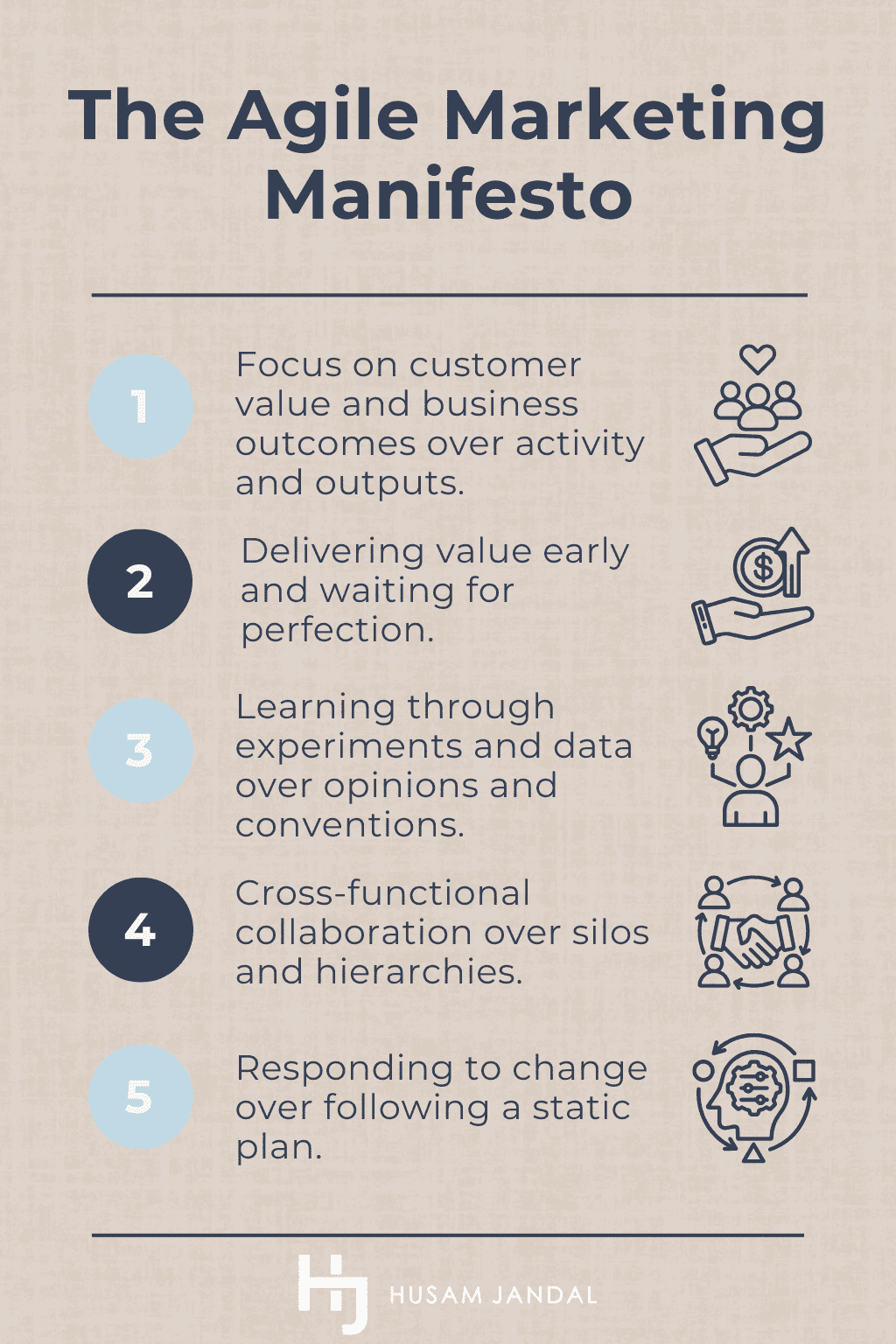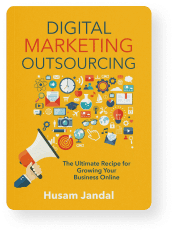 It’s often thought that small and medium enterprises (SMEs) are incapable of competing with large enterprises. After all, big companies typically have big budgets, teams, and technology to match their size. It’s the kind of setup many SMEs can only dream of. But, there’s one major area where large companies usually fall short: agility. When you use this to your advantage in marketing, you can gain a competitive advantage and grow rapidly. Give me a few minutes, and I’ll walk you through the basics of SME marketing agility and how to leverage it to outmaneuver big brands.
It’s often thought that small and medium enterprises (SMEs) are incapable of competing with large enterprises. After all, big companies typically have big budgets, teams, and technology to match their size. It’s the kind of setup many SMEs can only dream of. But, there’s one major area where large companies usually fall short: agility. When you use this to your advantage in marketing, you can gain a competitive advantage and grow rapidly. Give me a few minutes, and I’ll walk you through the basics of SME marketing agility and how to leverage it to outmaneuver big brands.
SME Marketing Agility: Definition and Background
Agile marketing is defined as “the extent to which an entity rapidly iterates between making sense of the market and executing marketing decisions to adapt to the market,” according to the American Marketing Association (AMA). In short, it’s the idea that a business can pivot quickly as needed to improve marketing outcomes.
Agile Project Methodologies
There are many approaches to agile project management, such as Scrum, Lean development, and Kanban. Many of these predate the term “agile” despite being considered agile methodologies. For instance, Kanban emerged on Toyota’s production line in the 1940s.
Agile’s rise to fame, however, came from software developers and the Agile Manifesto, which was formally introduced in 2001. The concept is based on the idea that project requirements will change as development progresses. Because of this, it makes more sense to deliver a limited version of a project first, then improve it over time.
Agile Marketing Manifesto
About a decade after the software industry adopted agile project management, marketers developed the Agile Marketing Manifesto. It has five key values.
- Focus on customer value and business outcomes over activity and outputs.
- Delivering value early and waiting for perfection.
- Learning through experiments and data over opinions and conventions.
- Cross-functional collaboration over silos and hierarchies.
- Responding to change over following a static plan.
Agile Marketing Techniques and Practices

Applying the agile framework to marketing makes sense. Your goalposts are constantly moving, especially in digital marketing. For instance, Google updates its search algorithm thousands of times each year, as Search Engine Journal reports. If you can’t pivot your SEO strategy in real time alongside these shifts, your site will lose rank. Moreover, customer needs and the technology they use are constantly shifting. If you can’t meet them where they are today, your messages won’t reach them or resonate with them.
It’s no surprise, then, that agile marketers are 469 percent more likely to report success than their peers, per CoSchedule. Even still, most marketing teams don’t go all-in. Instead, they apply agile methodologies selectively.
Sprint and Iteration Planning
Your team has probably engaged in sprint and iteration planning, whether you’ve referred to it as that or not. Nearly half of all marketing teams do, according to AgileSherpas surveys.
- Iteration: Iterations are about making incremental progress. When you plan an iteration, you plan the full scope of work, including execution, learning, and any necessary adjustments. For instance, you might want to see if shortening your contact form boosts conversions. Iteration planning would cover the entire span of A/B testing, results analysis, and applying the winning version.
- Sprint: Sprints are a specific aspect of the Scrum methodology, focusing on short-term deliverables. For instance, you might decide to launch a new email nurture sequence, and your sprint would include creating copy, designing templates, setting up automation, conducting quality control, and launching it.
Kanban Boards
In all, 45 percent of marketing teams leverage digital Kanban boards, while 14 percent use physical Kanban boards. With Kanban, the various stages of your work are distributed as columns. For instance, you might have “Planned,” “In Progress,” and “Complete.” Or, maybe you’re working on an article, and you have “Copywriting,” “Optimization,” “Editing,” “Final Review,” “Scheduling,” and “Complete.” Each task has its own card, and cards move through columns as the task is completed.

Most marketing project management platforms offer this functionality. For instance, Trello offers the visual experience of Kanban, while others, such as Wrike, allow you to visualize your work in various ways, including using Kanban boards.
Daily Standups
Daily standups usually last more than ten or 15 minutes, and typically center around three questions:
- What did you work on yesterday?
- What are you working on today?
- Are there any roadblocks preventing you from making progress?
The goal is to keep the team aligned and eliminate roadblocks in as little time as possible. In all, 44 percent of marketing teams say they use this strategy.
User Stories and/or Epics
User stories and epics are a big-picture way to look at what your customer wants or needs and how you plan to meet those needs over a longer period of time. For instance, your marketing team may recognize that they need to focus on customer retention and understand that improved onboarding will help. In this case, you might develop an epic that lasts a full quarter. Within this epic, you can then identify various stories that align with what a customer is experiencing, such as difficulty using your product or service or feeling that the perceived value is limited. From there, you’d create individual tasks that fit within each story. Nearly four in ten marketing teams use this approach.
Work in Progress Limits
Switching between tasks repeatedly throughout the day can be challenging even for the brightest minds, as each shift tends to create mental blocks. The more shifts a person has, the more time they lose to those blocks. For instance, a person working on a single task can devote 100 percent of their time to that task. However, a person working on five tasks wastes up to 75 percent of their time due to switching, according to Scrum.org. Research published by the American Psychological Association echoes this, but places the time wasted at closer to 40 percent of a person’s productive time.
Because of this, more than two-thirds of marketing teams set work-in-progress (WIP) limits as part of their agile initiatives.
Frequent Releases
Under a traditional software-based agile framework, frequent releases typically refer to releasing product updates. The idea is that you don’t wait for perfection. Instead, you give something of value to your users, and then use their feedback to improve it.
The same approach can be applied to marketing as well. For instance, you might develop an onboarding guide that covers the basics and then add sections over time. Or, you might develop an ad campaign and then refine your copy and images as you see what works with your audience. Roughly one-third of marketers use this approach.
Short Iterations
An equal number of marketing teams leverage short iterations. We tend to see this leveraged more often with A/B testing, although there are many potential applications, such as making minor tweaks to your email templates or refining your website over time. This approach is also excellent for search engine optimization (SEO) initiatives.
Retrospectives and Sprint/Iteration Reviews
Retrospectives and reviews have similar goals; ensuring alignment. However, reviews come first and focus on whether the product meets both company and customer needs. Retrospectives come after and focus on the process and collaboration. One-third of marketing teams include these in their processes.
Why SMEs are Primed for Agile Marketing
Even if you don’t fully adopt an agile approach to your marketing project management, your SME likely already has agility on its side.
Lean Organizational Structure vs. Silos
A key component in agile marketing is communication. While this naturally means everyone on the marketing team collaborates well, this collaboration must also extend to sales and operations. In smaller companies, this level of communication comes naturally, as team members are likely only a desk or an instant message away. It’s easy to reach out and ask for a progress update, request resources, or solicit feedback on the fly. With larger companies, individuals may not even know who else is handling other parts of a project, let alone how the final product will be used or if additional resources are available.
Fast Decisions vs. Bureaucracy
SMEs tend to have a small number of decision-makers. It’s quite common for only one or two people to have to sign off on initiatives. With large companies, there are often multiple layers, including an editor, manager, head of marketing, and more. Sometimes, legal teams and executives also get involved in decisions.
Being able to make decisions quickly is a significant advantage for SMEs. While a large company might need five people to sign off on reallocating a video budget to pay-per-click (PPC) ads, and have the process take weeks to implement, a smaller company can have it done in a day. This means less wasted budget and improved ability to seize new opportunities.
Direct Customer Relationships vs. Slow Feedback Loops
Smaller companies maintain close, direct relationships with customers. Because you’re closer to customer feedback, your business can swiftly spot trends, emerging demands, and opportunities for improvement.
Larger businesses generally lack the direct, personal relationships that SMEs enjoy with customers. Instead, they rely on lengthy market research processes, surveys, or analytics tools to gather insights. This prolonged feedback loop prevents rapid recognition of changing customer needs and emerging market trends.
Agile Mindsets vs. Risk Aversion
SMEs naturally cultivate an entrepreneurial spirit where innovation is highly valued. Employees are accustomed to wearing multiple hats, meaning your team is already primed to respond quickly and creatively to new opportunities or challenges.
Meanwhile, larger brands often prioritize stability and protecting their established market share. This makes them cautious about trying innovative or unproven strategies. The result is slow decision-making, as teams carefully weigh risks rather than rapidly seizing opportunities.
Easier Adoption of New Technologies vs. Legacy Systems
Many large corporations rely heavily on older, established technology infrastructure. These legacy systems are deeply integrated into their daily operations, making it complex and time-consuming to upgrade or shift to modern solutions.
With smaller and newer companies, this isn’t usually a significant issue. You’re likely already using the latest technology and cloud platforms that are constantly updated. If you want to change a critical component like your CRM, it will probably still be a challenge, but one that can be overcome with strong planning and some team training.
Ability to Experiment Rapidly vs. Slow Deployments
SMEs can test new ideas quickly, gather feedback, and iterate without excessive risk or bureaucracy. This flexibility means your business can innovate, fail quickly, adjust, and continually improve its strategies, allowing you to optimize marketing campaigns, products, or services based on real-world insights.
How to Outmaneuver Big Brands with Agile Marketing
Agility gives smaller businesses a real advantage. While larger organizations often get bogged down in planning and approvals, you can move quickly. Here’s how to turn that speed into a strategic edge.
Roll Out Fast and Refine as You Go
You don’t need every asset finalized before you launch. Push a campaign live, gather data, and make adjustments in real time. That might mean running an early version of a landing page, testing ad copy with a small audience, or sending a lean email sequence. What matters is getting in the market early while others are still in draft mode.
Turn Customer Feedback into Immediate Action
If your customers say something isn’t working, you can fix it without waiting for a department-wide meeting. Tweak the messaging. Update the visuals. Shift the offer. Larger companies often hear the same signals but take weeks to respond. You can respond in a day.
Use Small Wins to Build Smarter Campaigns
Agile marketing is about creating a feedback loop. You launch, observe what clicks, and build from there, each campaign sharper than the last. Start simple, look at the data, and develop your campaign piece by piece. Even if you only improve one element at a time, you’re already ahead of brands still chasing perfection on paper.
Work as One Team Instead of Several Departments
When sales, marketing, and operations are aligned, you don’t lose time to confusion or internal politics. You know who to ask. You know what to prioritize. And you’re not stuck waiting for four approvals to send one campaign. That kind of clarity beats bureaucracy every time.
Capitalize on Timing Others Miss
Big brands often miss cultural moments because they’re still deciding whether to participate. You can move when it matters. If a trend aligns with your brand, you don’t have to wait. You can show up, stay relevant, and lead the conversation while competitors are still debating their response.
How to Keep Your SME Agile as it Scales

As your SME grows, maintaining agility becomes increasingly important to sustain your competitive edge. Growth is exciting, but it can introduce complexity that slows down innovation. Here’s how your business can retain its agility even as you scale.
Preserve a Flat Organizational Structure
Keeping your organizational structure flat promotes faster decision-making. Even as you add team members, limit the number of management layers. By encouraging open communication across your team, you can avoid the delays common in larger companies. Spotify’s “squad” model exemplifies this—small, autonomous teams empowered to make rapid decisions, even as the company scaled globally.
Prioritize Company Culture
As your business expands, actively protect and cultivate your original agile culture. Clearly communicate core values, such as innovation, risk-taking, and flexibility, to ensure new hires fully embrace them. Regularly revisit your culture, seeking input from your team to reinforce agile principles.
Leverage Flexible Technology Solutions
Adopt technologies that can grow seamlessly with your business, allowing quick adaptation to evolving needs. Cloud-based solutions, scalable CRM platforms, and adaptable digital marketing tools ensure you remain nimble, enabling your business to quickly pivot without technology becoming an obstacle. HubSpot offers flexible, scalable tools that SMEs regularly use to quickly adjust their marketing and sales strategies as their customer base grows.
Maintain Direct Customer Engagement
Prioritize maintaining close relationships with your customers as you grow and expand. Create regular touchpoints, such as feedback loops, surveys, or dedicated customer success teams, to ensure continuous customer insights inform your strategies. By keeping a direct line to your customers, your business remains responsive and agile. Slack scaled while maintaining agility by consistently using customer feedback to drive feature updates and product improvements.
Implement Cross-Functional Teams
Build and encourage teams that collaborate across functions, rather than isolated, siloed departments. Cross-functional teams can respond more quickly, innovate more effectively, and solve problems more efficiently. Amazon famously uses small, cross-functional “two-pizza teams,” allowing them to rapidly innovate despite their massive size.
Continuously Evaluate and Streamline Processes
As your SME scales, frequently assess your internal processes. Identify bottlenecks, eliminate redundancies, and simplify wherever possible. By maintaining streamlined workflows, you ensure your business remains flexible, responsive, and ready to pivot quickly. Netflix regularly reviews and refines its internal practices to sustain agility and make rapid decisions, even with significant growth.
Outmaneuver Big Brands with a Tailored Agile Marketing Strategy
You don’t need to follow a strict methodology to benefit from agile marketing. In my experience, the ability to test, adapt, and move quickly is what gives smaller businesses a real advantage. If you’d like to explore what that might look like for your business, connect with me for a complimentary consultation.
FAQs on SME Marketing Agility
How do SMEs stay competitive in marketing?
SMEs stay competitive by responding quickly to customer needs, launching campaigns faster than larger companies, and adjusting strategies based on performance insights rather than long-term forecasts.
What does marketing agility mean for an SME?
Marketing agility for an SME means being able to shift messaging, offers, or entire campaigns quickly based on new information. It allows small businesses to stay relevant and effective in fast-changing markets.
Why are small businesses better at adapting their marketing?
Small businesses can pivot faster because they’re not slowed down by large teams, bureaucracy, or complex tech systems. Their size gives them the advantage of speed and direct access to customer feedback.
How can marketing flexibility help a small business grow?
Marketing flexibility allows a small business to test and refine ideas quickly. This reduces wasted spend and helps the business focus on strategies that actually move the needle, fueling faster growth.
How can I improve my SME’s marketing agility?
Start by simplifying approval processes, running small experiments, using customer feedback to guide messaging, and adopting tools like Kanban boards or sprint planning to stay focused.
Why do big brands struggle with agile marketing?
Big brands often face internal bottlenecks, such as long approval chains, rigid processes, and outdated systems. These prevent them from moving quickly and responding to changes in real-time.
Is agile marketing better for small businesses or large ones?
Agile marketing tends to be more effective for small businesses because they can act quickly, test ideas with minimal risk, and adjust faster based on the results. Larger brands benefit too, but they face more challenges in implementation.
How can SMEs outmaneuver bigger companies in digital marketing?
SMEs can outperform big brands by launching faster, adjusting their strategies based on customer feedback, and focusing on high-impact campaigns. Their agility lets them act while others are still planning.
What’s the competitive advantage of agile marketing for SMEs?
Agile marketing gives SMEs a competitive advantage by allowing them to experiment, adapt, and respond faster than their larger competitors. It reduces time-to-market and helps them stay in sync with customer expectations.
How do small businesses apply agile methods to marketing?
Small businesses can apply agile methods by setting short-term goals, using tools like Kanban boards, regularly reviewing campaign results, and adjusting their strategy based on real-world data.
What tools help SMEs stay flexible with marketing?
Tools like Trello, Asana, and HubSpot help SMEs plan campaigns, track progress, and pivot as needed. Many offer features like drag-and-drop workflows, automation, and collaboration tools.
What’s an example of agile marketing in a small business?
An example might be launching a simple lead magnet, analyzing signups, then refining the campaign based on customer feedback and conversion rates, rather than waiting until everything is perfect.
How do I run marketing sprints in a small business?
To run marketing sprints, choose a focused goal, assign specific tasks, minimize distractions, and measure results within a set timeframe —typically one to two weeks.




































































